Living Room TV Unit Design Ideas And Materials For Your Home Interiors
- Pescora Design

- Jul 15
- 7 min read
The living room is often the heart of a home, where friends and family gather, relax, and enjoy entertainment together. A thoughtfully designed TV unit can make all the difference in tying the room together, balancing aesthetics with functionality. Here’s an in-depth guide to living room TV unit design ideas and materials for a stylish home, and how to select the perfect option for your home.
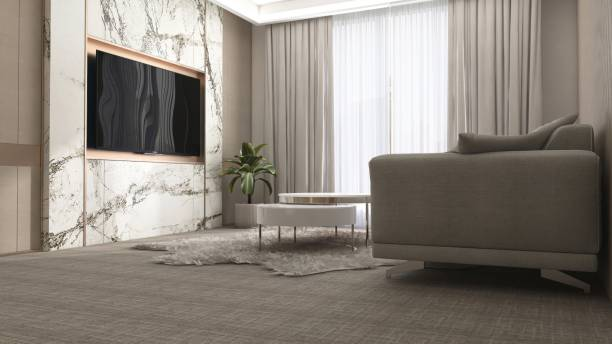
Glossary
1. Wall-Mounted Living Room TV Unit Design Ideas and Materials for a Stylish Home
A wall-mounted TV unit design is sleek, space-saving, and ideal for modern, minimalistic interiors. By keeping the TV and unit flush against the wall, you create a clutter-free look that blends seamlessly with your décor.

Material Options:
Laminate: A popular, cost-effective choice that is easy to maintain.
Wood Veneer: Adds a natural look and warmth, though it requires some care.
MDF with High Gloss Finish: For a shiny, modern appearance that’s easy to clean.
Design Tips:
Opt for slim shelves for storing media and displaying decorative items.
Choose a darker finish if you want the unit to blend into the wall, or a contrasting color to make it a focal point.
2. Freestanding TV Cabinets
Freestanding TV units are versatile and available in various styles, from vintage cabinets to contemporary modular systems. They’re ideal for larger living rooms and add an element of luxury.

Material Options:
Solid Wood: Adds durability and a luxurious feel, perfect for traditional or rustic interiors.
Engineered Wood: Affordable and available in many finishes, such as walnut and mahogany.
Metal Accents: Often used in combination with wood or glass for a modern, industrial look.
Design Tips:
Look for units with closed storage for a neat look.
Choose an eye-catching design with open shelving to showcase decorative items.
3. Floating TV Units
Floating TV units provide an airy and light appearance, which works well in smaller living rooms. Mounted on the wall without any legs touching the floor, this unit style leaves floor space open, enhancing the room’s spaciousness.

Material Options:
Plywood with Veneer Finish: Lightweight and easy to mount on walls.
Glass: Creates a contemporary, almost transparent look, though it requires frequent cleaning.
Laminates in Glossy Finishes: Ideal for a sleek and modern look, they are also easy to clean.
Design Tips:
Combine with LED backlighting for a stylish, dramatic effect.
Add some shelves underneath or alongside for added storage.
Check out our Pinterest board to discover more TV unit ideas.
4. Entertainment Console Units
These units combine a large storage console with ample space for the TV. With various storage options, from shelves and cabinets to drawers, they’re excellent for homes with multiple devices and accessories.
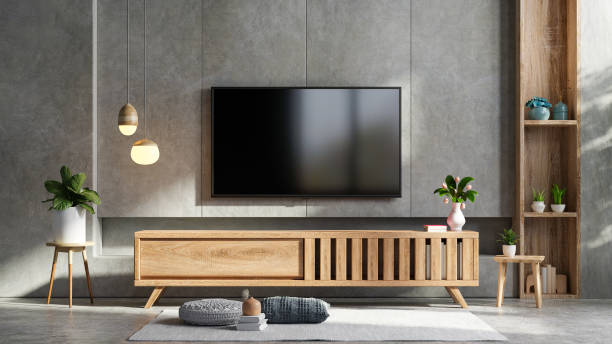
Material Options:
Wood and Metal Combination: Adds a balanced, industrial vibe that suits contemporary spaces.
Laminate with a Matte Finish: Reduces glare and adds a subtle finish.
Mirrored Accents: Brings in a touch of elegance and opens up the space visually.
Design Tips:
Choose a console with a cable management system for a clutter-free appearance.
Pair with decorative storage baskets to hide remotes and chargers.
5. Corner TV Units
Corner TV units in home interiors make the most of unused space in smaller rooms. They are compact and fit snugly into the room’s corner, optimizing space and freeing up the central wall for other furniture or décor.
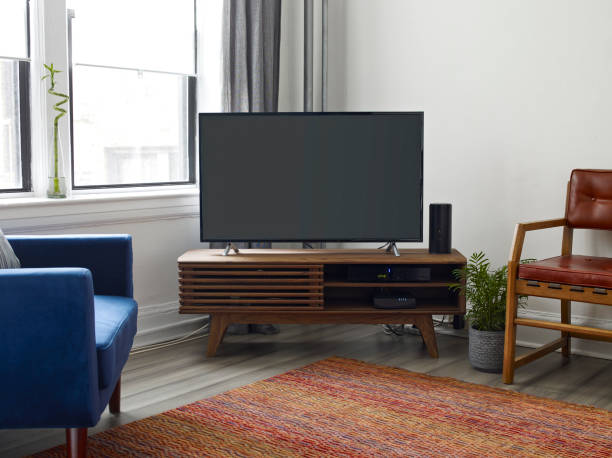
Material Options:
Solid Wood or Engineered Wood: For a sturdy, stable unit that can hold a TV and other items.
Metal and Glass: Creates a sleek, modern look, especially in contemporary homes.
MDF with Laminate: Ideal for budget-friendly options that still look elegant.
Design Tips:
Ensure the TV angle is suitable for viewing from multiple seating areas.
Opt for open shelving if you need easy access to media devices.
6. Built-In Wall Units
For an integrated, cohesive look, built-in wall units are a fantastic choice. They create a customized look and maximize living rooms interior space by combining storage, display, and entertainment areas.

Material Options:
MDF or Plywood with Paint Finish: Allows for a fully customized color scheme.
Glass Doors: For enclosed shelves, they keep dust out while displaying items.
Wood Veneer: Provides a classic, natural finish that is versatile across styles.
Design Tips:
Go for floor-to-ceiling units to maximize storage space.
Paint the built-in unit in the same color as the walls for a seamless, cohesive look.
7. Minimalist TV Stands
Minimalist TV stands are ideal for homeowners who prefer a clean, simple look. These stands are generally open-shelf units with a sleek design that complements modern and Scandinavian interiors.
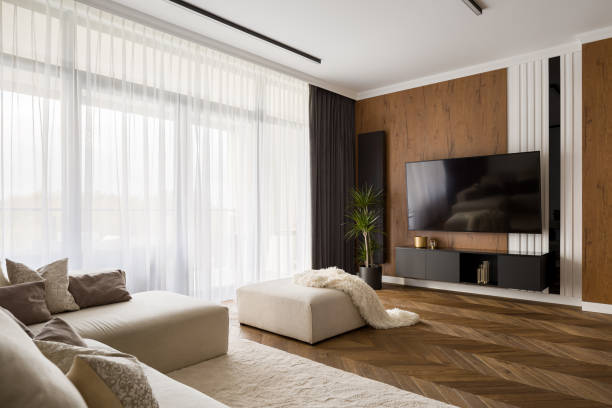
Material Options:
Metal with Matte Black Finish: For an industrial look with durability.
Light Wood with a Clear Lacquer: Maintains a natural, airy appearance.
Glass Shelving: Adds a minimal, almost invisible structure.
Design Tips:
Avoid too many accessories; let the TV and stand speak for themselves.
Add a few select items like small plants or a single sculpture for balance.
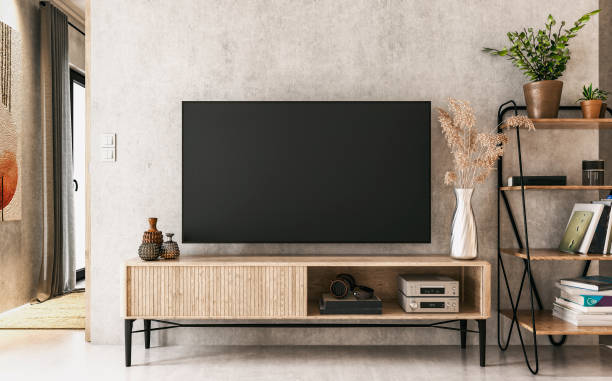
Things to Consider Before Choosing a TV Unit
Before jumping into specific styles or materials, it’s important to evaluate what works best for your space and lifestyle. Here are a few key factors to consider:
Room Size & Layout: In compact living rooms, wall-mounted or floating TV units work best as they save floor space. For spacious rooms, freestanding or built-in units can anchor the space beautifully.
TV Size & Viewing Height: The unit should align with the center of your TV screen at eye level when seated. This ensures comfortable viewing and enhances the visual symmetry of the space.
Storage Needs: If you have multiple devices like gaming consoles, soundbars, or set-top boxes, choose a design with built-in shelves or closed cabinets to keep everything organized.
Interior Style & Color Scheme: Match the unit’s color and material to your existing furniture. Wood finishes complement rustic or classic spaces, while glossy laminates or metal finishes suit modern interiors.
Cable Management: Always look for units with in-built cable management systems to keep wires out of sight and maintain a clean, streamlined look.
Styling Tips for Your TV Unit
Once your TV unit is in place, styling it well can enhance your living room’s overall ambiance. Here are some decor ideas to elevate its aesthetic:

Add Greenery: Small indoor plants like succulents or trailing pothos add a natural touch and balance the electronics with organic elements.
Use Accent Lighting: Install LED backlights or mount small sconces above the unit to create a cozy glow and highlight the wall.
Display Thoughtfully: Use open shelves for a mix of function and decoration—stack a few books, display ceramic pieces, or frame photos without cluttering the space.
Keep It Balanced: Symmetry can create harmony. For example, placing two similar decor items on either side of the unit offers a neat, cohesive look.
Add Personal Touches: Incorporate objects that reflect your personality be it travel souvenirs, art prints, or a mini speaker system with style.
Choosing the Right Material for Your TV Unit
Selecting the right material for your TV unit is as essential as the design itself. Each material has its unique characteristics and suitability, which may vary based on factors like durability, maintenance, style, and budget. Here is a table summarizing the different material options and their pros and cons:
Material | Description | Pros | Cons | Best for |
Solid Wood | Durable, high-quality material with a classic appeal. | Long-lasting, luxurious look | Expensive, needs maintenance | Traditional or rustic interiors |
Engineered Wood | Composite material with wood-like appearance; available in multiple finishes. | Cost-effective, lightweight | Less durable than solid wood | Contemporary or budget-friendly homes |
MDF with Laminate | Medium-density fiberboard with laminate; available in glossy or matte finishes. | Easy to clean, budget-friendly | Less durable than solid wood | Modern, minimalist spaces |
Glass | Clear or frosted glass used for shelving or as a stand material. | Sleek, modern appearance | Prone to smudges, fragile | Contemporary or minimalistic designs |
Metal | Often used as accents or legs, metal can provide an industrial look. | Strong, modern | Can appear cold, needs careful styling | Industrial or eclectic interiors |
Wood Veneer | Thin layer of natural wood over plywood or MDF, adding a rich, natural look. | Affordable with a natural appearance | Requires maintenance, can chip | Traditional or transitional styles |
Glass and Metal | Combination of glass and metal elements, usually for modern or industrial units. | Sleek, reflective surfaces | Fragile, requires regular cleaning | Industrial or contemporary spaces |
Mirrored Finishes | Used as accents, mirrored finishes add elegance and visual space. | Luxurious, visually enlarges spaces | Prone to fingerprints, requires upkeep | Glamorous or compact spaces |
Conclusion
Selecting the right TV unit design and material can transform your living room into a more functional and visually appealing space. From wall-mounted units that save space to freestanding cabinets for more storage, each design and material has its own unique set of benefits. Whether you’re looking to create a cozy corner or a sleek modern space, choosing the right combination of design and materials will make all the difference in achieving the desired ambiance for your home.
Check out our latest blog about 2024 living room trends.
FAQs:
What is the best type of TV unit for a small living room?
For smaller spaces, wall-mounted or floating TV units are ideal. They save floor space, offer a modern look, and can include shelves or hidden storage to minimize clutter.
How do I choose the right material for my TV unit?
Consider your budget, style preference, and maintenance needs. For example:
Solid wood offers luxury and durability but is expensive.
MDF with laminate is affordable and easy to clean.
Glass and metal provide a modern look but require more upkeep.
Can I mount a TV on any kind of TV unit?
Not all units support mounting. To mount a TV, you’ll need either a wall-mounted unit with strong structural backing or a floating unit designed to support wall fixtures. Always check weight capacity and wall type before installation.
Are freestanding TV cabinets outdated?
No, freestanding TV units are still popular for larger spaces. They offer ample storage and can act as statement furniture pieces, especially when made from rich materials like solid wood or accented with metal and glass.
How do I hide cables and wires for a cleaner look?
Look for units with built-in cable management systems, or use cable covers and clips. Built-in and entertainment console units typically offer the best cable-hiding solutions.
Can built-in TV units be customized?
Yes! Built-in units offer the highest level of customization. You can tailor them to your space, storage needs, and style—whether you want open shelves, hidden cabinets, or integrated lighting.

Excellent breakdown of project planning steps! For anyone exploring construction options, Vulcan Hats Construction are reliable custom home builders toronto.